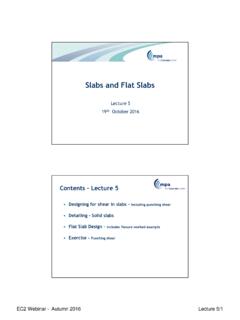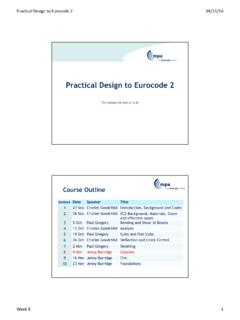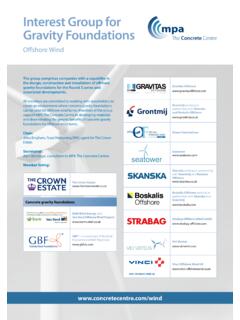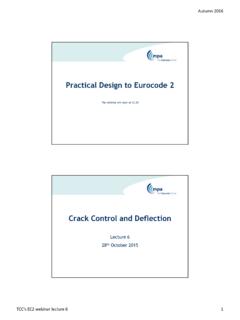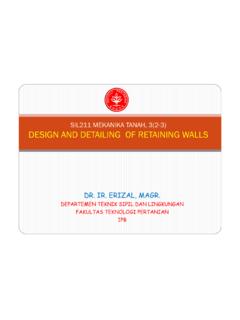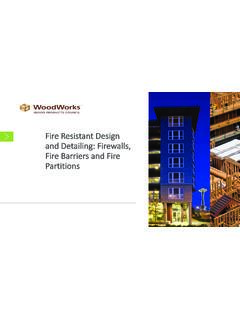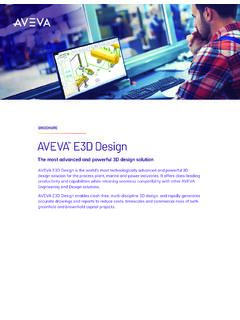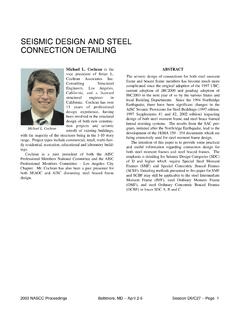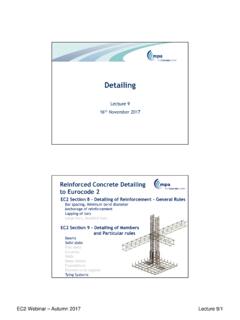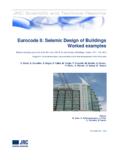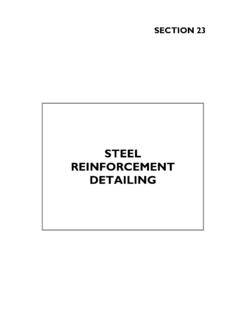Transcription of Practical Design to Eurocode 2
1 Autumn 2016 TCC's Eurocode Webinar course: lecture 21 Practical Design to Eurocode 2 The webinar will start at Background, Materials, Cover and Effective SpansLecture 228thSeptember 2015 Autumn 2016 TCC's Eurocode Webinar course: lecture 22Q2. Continuous single-way permanent actions = 6 kN/m2and variable actions = 4 kN/m2, calculate the value of ULS total loading (kN/m2) using Exps ( ), ( ) and ( ) (see BS EN 1990 Table (B) & UK NA). cantilever the Ffactors that should be applied to Gkand Qk:-a) for equilibrium (EQU) (BS EN 1990, Table (A) & UK NA)b) for structural strength (STR) (BS EN 1990, Exp ( ) & UK NA) laReminder: last week:Exercise: Load Arrangements5m5m5mlaLoad Arrangements: Model AnswersQ2 GGkor GGk QQkor Q 0 Qkn( ) x 6+ x 4= kN/m2( ) x 6+ x x 4= kN/m2( ) x x 6+ x 4= kN/m2Q1 Span GGk+ QQkCant GGk+ Gk+ # #Gk+ #Gk+ #Gk# or Gkin each caseAutumn 2016 TCC's Eurocode Webinar course: lecture 23UK NA Load Arrangements.
2 GkSTR/GEO - - - 2 STR/GEO - values of actions, ultimate limit state persistent and transient Design situations (Table (B) Eurocode )Comb tionexpression reference Permanent actionsLeading variable actionAccompanying variable actionsUnfavourableFavourableMain(if any) OthersEqn ( ) G,j,sup Gk,j,sup G,j,inf Gk,j,inf Q,1Qk,1 Q,i 0,iQk,iEqn ( ) G,j,sup Gk,j,sup G,j,inf Gk,j,inf Q,1 0,1Qk,1 Q,i 0,iQk,iEqn ( ) G,j,supGk,j,sup G,j,inf Gk,j,inf Q,1Qk,1 Q,i 0,iQk,iULS (GEO/STR)for UK BuildingsEqn ( ) Qk, 0,iQk,iEqn ( ) 0, 0,iQk,iEqn ( ) Qk, 0,iQk,iFor buildings Exp ( ) is usually used >> Gk+ QkBut Exp ( ) could be used and for one variable action >> Gk+ QkProvided:1. Permanent actions < x variable actions2. Excludes storage transient Design situationdesign situation that is relevant during a period much shorter than the Design working life of the structure and which has a high probability of A transient Design situation refers to temporary conditions of the structure, of use, or exposure, during construction or persistent Design situationdesign situation that is relevant during a period of the same order as the Design working life of the structure NOTE Generally it refers to conditions of normal 2016 TCC's Eurocode Webinar course: lecture 24 Summary: Lecture 2 Background & Basics Concrete Reinforcement Durability and Cover A Few Definitions ExercisesBackground to Eurocode 2BS EN 1992 Design of concrete structures MaterialsAutumn 2016 TCC's Eurocode Webinar course.
3 Lecture 25 UKCEB/fibEurocode 21968CP114 (CP110 draft)Blue Book (Limit state Design )1972CP110 (Limit state Design )Red Book1975 Treaty of Rome1978 Model Code 781985BS8110 Eurocode 2 (EC)1990 Model Code 901993EC2: Part 1-1(ENV) (CEN)2004EC2: Part 1-1 (EN)2005UK Nat. 66872010EC2BS8110 withdrawn Model Code 20102013(final) MC2010WG and 10 TGs2016 Project Team redrafting. WG and 10 TGs2020?EC2 v2?EC2 v2? Eurocode 2: Context BS EN 1992-1-1: General Rules and Rules For Buildings BS EN 1992-1-2: Fire Resistance of Concrete Structures BS EN 1992-2: Reinforced and Prestressed ConcreteBridges BS EN 1992-3: Liquid Retaining StructuresEurocode 2: Design of Concrete StructuresAutumn 2016 TCC's Eurocode Webinar course: lecture 26 Eurocode Hierarchy+ PDs+ NA+ NA+ NAs+ NA+ NAEN 1990 Basis of DesignEN 1991 Actions on StructuresEN 1992 ConcreteEN 1993 SteelEN 1994 CompositeEN 1995 TimberEN 1996 MasonryEN 1999 AluminiumEN 1997 Geotechnical DesignEN 1998 Seismic DesignStructural safety, serviceability and durabilityDesign and detailingGeotechnical & seismic designActions on structuresThese affect concrete designEurocode 2: relationshipsBS EN 1990 BASIS OF STRUCTURAL DESIGNBS EN 1991 ACTIONS ON STRUCTURESBS EN 1992 Design OF CONCRETE STRUCTURESPart 1-1: General Rules for StructuresPart 1-2: Structural Fire DesignBS EN 1992 Part 2.
4 BridgesBS EN 1992 Part 3: Liquid Ret. StructuresBS EN 1994 Design of Comp. EN 13369 Pre-cast ConcreteBS EN 1997 GEOTECHNICAL DESIGNBS EN 1998 SEISMIC DESIGNBS EN 13670 Execution of StructuresBS 8500 Specifying ConcreteBS 4449 Reinforcing SteelsBS EN 10080 Reinforcing SteelsBS EN 206 ConcreteNSCSDMRB?NBS?Rail?CESWI?BS EN 10138 Prestressing SteelsAutumn 2016 TCC's Eurocode Webinar course: lecture deals with phenomena, rather than element types so bending, shear, torsion, punching, crack control, deflection control (not beams, slabs, columns) is based on characteristic cylinder derived formulae ( only the details of the stress block are given, not the flexural Design formulae) tips ( concentrated loads, column loads, ) of stress in for ribbed reinforcement fy400 MPa 600 MPa (Plain or mild steel not covered but info on plain and mild steel given in PD 6687) horizontal loads considered in additionto lateral strength, up to C90/105 materials or workmanship section (refer to various ENs)
5 General notes on Eurocode related to requirements for durability, fire and bond also subject to allowance for deviations due to variations in strut inclination method for shear checks at 2d from expressed as axis y and minor axis zGeneral notes on Eurocode 2yyzzxxAutumn 2016 TCC's Eurocode Webinar course: lecture 28EN1992-1-1: Contents1. General2. Basis of design3. Materials4. Durability and cover to reinforcement5. Structural analysis6. Ultimate limit states7. Serviceability states8. detailing of reinforcement and prestressing tendons General9. detailing of members and particular rules10. Additional rules for precast and concrete elements and structures11. Lightweight aggregated concrete structures12. Plain and lightly reinforced concrete structuresA.(Informative) Modification of partial factors for materialsB.(Informative) Creep and shrinkage strainC.(Normative)Reinforcement propertiesD.(Informative) Detailed calculation method for pre-stressing steel relaxation lossesE.
6 (Informative) Indicative Strength Classes for durabilityF.(Informative) Reinforcement expressions for in-plane stress conditionsG.(Informative) Soil structure interactionH.(Informative) Global second order effects in structuresI.(Informative) Analysis of flat slabs and shear wallsJ.(Informative) Examples of regions with discontinuity in geometry or action ( detailing rules for particular situations) EN1992-1-1: AnnexesUse BS8500 Alternative Annex J in PD 6687 Autumn 2016 TCC's Eurocode Webinar course: lecture 29 Basis of designBasis of Design ( ) Use EN 1990 Use EN 1991 Partial material factors, MNB. alternative Msin EC 7 Fastenings should be subject to an ETA (NB. EN 1992-4, Fasteners out soon!) Design situation Cfor concrete Sfor reinforcing steel Sfor prestressing steelPersistent and and NAAutumn 2016 TCC's Eurocode Webinar course: lecture 210 ConcreteConcrete properties (Table ) BS 8500 includes C28/35 & C32/40 For shear Design , max shear strength as for C50/60 Strength classes for concrete fck(MPa) 12 16 20 25 30 35 40 45 50 55 60 70 8090fck,cube (MPa) 15 20 25 30 37 45 50 55 60 67 75 85 95 105fcm(MPa) 20 24 28 33 38 43 48 53 58 63 68 78 8898fctm(MPa) (GPa) 27 29 30 31 33 34 35 36 37 38 39 41 4244fck= Concrete cylinder strength fck,cube= Concrete cube strength fcm= Mean concrete strength fctm= Mean concrete tensile strength Ecm= Mean value of elastic modulusEurocode 2 Autumn 2016 TCC's Eurocode Webinar course.
7 Lecture 211 Design Strength Values ( ) Design compressive strength, fcdfcd= ccfck/ c Design tensile strength, fctdfctd= ctfctk, / c cc(= (flexure) and (shear))and ct(= )are coefficients to take account of long term effects on the compressive and tensile strengths and of unfavourable effects resulting from the way the load is appliedfctk, = fctmFor a C30/37 concrete what is fcd?Poll: Design compressive strength, fcda MPab MPac MPad MPae MPaf MPaAutumn 2016 TCC's Eurocode Webinar course: lecture 212 For a C30/37 concrete what is fctd?Poll: Design tensile strength, Deformation ( ) Values given in EC2 are indicative and vary according to type of aggregate. Ecm(t) = (fcm(t)/fcm)0,3 Ecm Ta n g e n t m o d u l u s , Ec, may be taken as Ecm Poisson s ratio for uncracked concrete = for cracked concrete = 0 Linear coeff. of thermal expansion = 10 x 10-6K-1 Autumn 2016 TCC's Eurocode Webinar course: lecture 213 Creep ( )01,02,03,04,05,06,07,0100503012351020t0 ( t0)SNR100300500700900110013001500C20/25C 25/30C30/37C35/45C40/50C45/55C50/60C55/6 7C60/75C70/85C90/105C80/95h0 (mm)Inside conditions RH = 50%Example: 300 thick ground bearing slab, loading at 30 days, C30/37h0= 2Ac/u whereAcis the cross-section area and u is perimeter of the member in contact with the atmosphere = ( )Shrinkage Strain, cs, is composed of two components: Drying Shrinkage Strain, cd, develops slowly Autogenous Shrinkage Strain, ca, develops during the hardening of the concrete.
8 Drying shrinkage, cd cd(t) = ds(t,ts) kh cd,0(EC2, Exp ( )Autogenous shrinkage, ca ca(t) = as(t) ca( ) (EC2, Exp ( )(There is more information on creep and shrinkage in Annex B)Autumn 2016 TCC's Eurocode Webinar course: lecture 214 Creep and Shrinkage Annex B Creep 0 is the notional creep coefficient (in Figure the notation used is ( ,t0)) (t,t0) is the creep at any time, tafter time of loading, t0 Shrinkage cd,0is the basic drying shrinkage strain cd,(t) = ds(t,ts)kh cd,0(Section 3)fcd c2 c cu2 c0fckFor section analysis Parabola-rectangle c3 cu30fcd c cfck Bi-linear fcm0,4 fcm c1 c cu1 ctan = Ecm For structural analysis Schematic c1( ) 0,7 cu1 ( )= + 27[(98-fcm)/100]4fcm)/100]4for fck 50 MPa otherwise c2 ( )= + (fck-50)0,53for fck 50 MPa otherwise 2,0 cu2 ( ) = + 35 [(90-fck)/100]4for fck 50 MPa otherwise = + [(90-fck)/100]4for fck 50 MPa otherwise fncccdcc2c211for0 fforccdc2ccu2 c3 ( )= + [(fck-50)/40]for fck 50 MPa otherwise cu3 ( ) = +35[(90-fck)/100]4for fck 50 MPa otherwise Stress Blocks ( and )Autumn 2016 TCC's Eurocode Webinar course.)
9 Lecture 215up to C50/60 StressStrainUltimate strainreducesStrain at maximumstress increasesC90/105 Change in Shape of Concrete Stress Block for high strength concretesAsd fcdFs x sx cu3Fc Ac = fck 50 MPa= (fck 50)/200 for 50 < fck 90 MPa400)50( ckfor 50 < fck 90 MPa = for fck 50 MPaRectangular Concrete Stress Block ( , Figure )Autumn 2016 TCC's Eurocode Webinar course: lecture 216 Flexural Tensile Strength ( ) The mean tensile strength, fctm,fl, depends on the mean axial strength and the depth of the cross sectionfctm,fl= max{( h/1000)fctm; fctm} This relationship also applies to the characteristic tensile values For Serviceability calculations care should be taken in using fctm,fl(See Section 7)Confined Concrete ( ) c2,c cu2,c c cfck,cfcd,c0 A 2 3 ( = 2) 1 = fck,cfck cufck,c= fck( + 2/fck) for 2 fck( + 2/fck) for 2> c2,c= c2(fck,c/fck)2 cu2,c= cu2+ 2/fckAutumn 2016 TCC's Eurocode Webinar course: lecture 217 ReinforcementReinforcement (1)( and ) EC2 does not cover the use of plain reinforcement Principles and Rules are given for deformed bars, decoiled rods, welded fabric and lattice girders.
10 Material properties are given in Annex C of EC2. BS 4449 aligns with Annex C. (When finally published EN 10080 should provide the performance characteristics and testing methods but will not specify the material properties.)Autumn 2016 TCC's Eurocode Webinar course: lecture 218 Product form Bars and de-coiled rods Wire Fabrics Class A B C A B C Characteristic yield strength fyk or f0,2k (MPa) 400 to 600 k = (ft/fy)k 1,05 1,08 1,15 <1,35 1,05 1,08 1,15 <1,35 Characteristic strain at maximum force, uk (%) 2,5 5,0 7,5 2,5 5,0 7,5 Fatigue stress range (N = 2 x 106) (MPa) with an upper limit of 150 100 cold workedseismichot rolledThe UK has chosen a maximum value of characteristic yield strength, fyk= 600 MPa, but 500 MPa is the value assumed in BS 4449 and BS 4483 for normal (Annex C) ft= kfykt uk fykHot rolled steelCold worked steel The Design value for Esmay be assumed to be 200 GPaReinforcement( , figure )Autumn 2016 TCC's Eurocode Webinar course.
